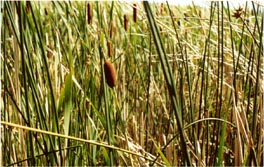Wetlands
Web Module
Scott J. Conaway
Alejandra De Obeso
Dr. Nihat M. Gürmen
Prof. H. Scott Fogler
 Problems - Model
Problems - Model
![]()
![]()
![]()
Assuming that the degradation of chemicals follows irreversible first-order homogeneous kinetics, and that some of the water evaporates from the surface as it flows through the wetlands, we need to come up with an equation that represents the molar flow of toxics (FA) as a function of distance (z). We must also consider that the superficial evaporation occurs at a constant rate (Q = kmol water / hr*m2) and that none of the chemicals are lost to the air by evaporation.
Consider the additional information given in the problem statement:
The first step consists in deriving an equation for the molar flow of toxics, FA, as a function of distance through the wetlands, z. We must first consider de equations pertaining to a PFR in relation to conversion. For example, we know that the final flow of toxics, FA, depends of the initial flow, FAO, and what did not react (1). We also know the equation that relates the rate of reaction, conversion, and change in volume (2). Since the reaction is first-order homogeneous, its equation must be (3).
(1) (2) (3) We must now relate concentration and molar flow to the volumetric flowrate, which is given in the initial data conditions. Since the final volumetric flowrate, v, is the difference between the initial vo and the volumetric flowrate at the exit, we can represent it as a simple subtraction. However, for the vf we must consider the superficial evaporation of water (Q) that multiplied by the surface area of the wetland (W*L or W*z) and divided by molar density will yield the adecuate units (m3/hr) as shown in equation (4).
(4) The equation that relates CA and FA directly is (5):
(5) Combining equations (1), (4), and (5), we obtain the general expression (6) that relates concentration as a function of distance.
(6) Afterwards, to combine the reaction rate with the new expression for concentration we must substitute equation (3) into equation (2). Then, the volume differential (dV) in (2) must be represented as a multiplication of W*D*dz, meaning that the length of the wetland is still variable, and the Width and Depth are constant. Using equation (5), we can translate the value of FAO as a multiplication of CAO*vo. Finally, the CA in (3) is substituted in with the expression obtained in (6). The result is the PFR equation ready for integration, equation (7):
(7) By rearrangement and grouping of constant terms, we arrive at equation (8):
(8) Calculating the definite integrals with the boundary conditions x = 0 at z = 0, and x = X at z = Z, we obtain equation (10):
(9) (10) Rearranging and solving the equation for conversion (X) in function of distance (Z), we obtain expression (11):
(11) where Finally, by placing this result back into the original equation (1) for FAO, we come to the final equation for our PFR model (12):
(12) where Tip: If we chose to model the case with no evaporation or rainfall in the wetlands (Q = 0 and therefore v = vo), we would come up with the following solution (13):
(13)
